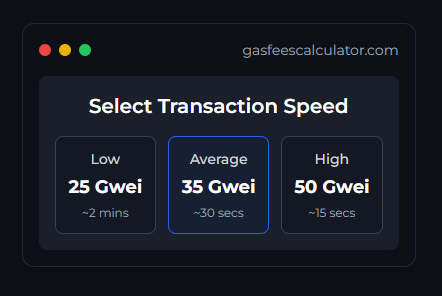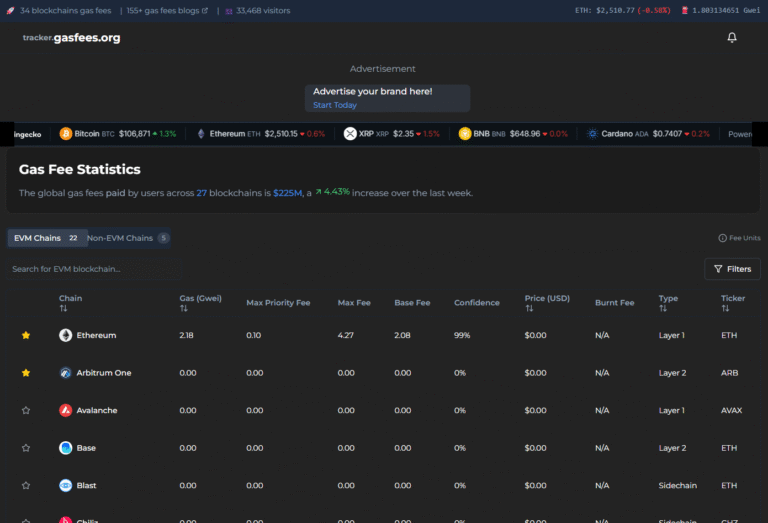
What Are Ethereum Gas Fees?
Denominated in gwei, a smaller denomination of Ethereum’s native cryptocurrency, Ether (ETH), the cost of gas fees is determined by the transaction’s computational requirements and the prevailing gas price, which is influenced by the level of network congestion. Understanding Ethereum gas fees is crucial for users engaging in activities on the Ethereum network, as it directly impacts the cost and efficiency of transactions.
In the realm of cryptocurrencies, Ethereum reigns as one of the most influential blockchain platforms.
Ethereum has not only transformed the way we view decentralized applications (DApps) but has also introduced a unique concept known as “eth gas fees.“
In this thorough guide, we will delve deep into the nuances of Ethereum gas fees, elucidating their definition, functioning, and significance within the Ethereum ecosystem.
The Essence of Ethereum
Before immersing ourselves in the intricacies of gas fees, let’s first grasp the foundational aspects of Ethereum. Conceived by Vitalik Buterin in 2015, Ethereum is a decentralized blockchain platform tailored to support smart contracts and DApps. These applications rely on the Ethereum Virtual Machine (EVM) to execute code autonomously, providing users with a secure and trustless environment.
The Role of Gas
In Ethereum, each action necessitates computational resources, encompassing processing power and storage. To uphold network efficiency and security, Ethereum introduced the concept of “gas.” Gas represents the expense incurred when performing actions on the network, be it sending transactions or executing smart contracts.
Deconstructing Gas Fees
Gas fees encompass the costs incurred by users when executing transactions or smart contracts on the Ethereum network. These fees serve dual roles:
-
- Incentivization: Gas fees act as incentives for miners to include transactions within the blockchain. Miners prioritize transactions with higher gas fees, as they receive these fees as rewards for their efforts.
-
- Resource Allocation: Gas fees efficiently allocate network resources. Users with a preference for expedited transaction processing can opt for higher gas fees, ensuring their requests receive priority.
Nevertheless, gas fees can fluctuate widely, dependent on network congestion and the complexity of the transaction or contract. During network congestion, users may find themselves needing to pay higher gas fees to ensure their transactions are expedited.
The Mathematics of Gas Fees
Calculating gas fees requires consideration of two primary factors: gas price and gas limit.
-
- Gas Price: The gas price denotes the cryptocurrency amount (typically measured in Ether) users are willing to pay for each unit of gas. Denominated in Gwei, a subunit of Ether, users can set the gas price according to their preferences. A higher gas price generally results in swifter transaction processing.
-
- Gas Limit: The gas limit dictates the maximum amount of gas users are willing to expend on a transaction or smart contract execution. It serves as a safeguard against unforeseen high costs resulting from code errors or vulnerabilities.
To compute the total gas fee for a transaction, users must multiply the gas price by the gas utilized during the transaction.
Additionally, it is noteworthy that Ethereum wallets and exchanges often provide users with gas fee estimations, simplifying the process of determining the appropriate fee for their transactions.
Variables Influencing Gas Fees
Numerous factors can exert an influence on the cost of gas fees within the Ethereum network. Familiarizing oneself with these variables can empower users to make informed decisions:
-
- Network Congestion: Peak periods of demand, such as ICOs, NFT launches, or DeFi activities, can lead to network congestion. Heightened demand can drive gas fees upward as users vie for limited resources.
-
- Gas Price Dynamics: Gas prices can fluctuate based on market dynamics and user demand. Observing gas price trends can aid users in determining optimal transaction initiation times.
-
- Smart Contract Complexity: The complexity of a smart contract directly correlates with the gas required for execution. Users should anticipate higher gas fees when interacting with intricate contracts.
-
- Gas Price Bidding: Certain wallets and platforms enable users to bid on gas prices to prioritize their transactions. However, hasty bidding can result in overpayment.
Nonetheless, users possess the flexibility to adjust gas fees in accordance with their requirements. During periods of reduced network activity, it is feasible to pay lower gas fees while still ensuring timely transaction processing.
Strategies for Gas Fee Reduction
For users desiring to minimize gas fees, several strategic approaches can be considered:
-
- Off-Peak Timing: Initiating transactions during periods of lower network activity can translate into lower gas fees.
-
- Smart Contract Optimization: Developers have the capacity to optimize smart contracts, reducing their gas consumption and enhancing cost-effectiveness.
-
- Wallet Selection: Certain wallets offer gas optimization features, guiding users toward the most cost-efficient transaction execution methods.
-
- Layer 2 Solutions: Ethereum is exploring Layer 2 scaling solutions such as Optimistic Rollups and zk-Rollups, promising expedited transactions and diminished fees.
Furthermore, Ethereum’s progression toward Ethereum 2.0, an upgrade aiming to replace the current proof-of-work (PoW) consensus mechanism with proof-of-stake (PoS), bears the potential to significantly diminish gas fees. PoS eliminates energy-intensive mining, resulting in a more sustainable and economical network.
Gas Fees in Decentralized Finance (DeFi)
Gas fees play a pivotal role in the decentralized finance (DeFi) arena, where a plethora of financial activities, including lending, borrowing, and trading, transpire. Users participating in DeFi protocols must conscientiously contemplate gas fees, as these fees can significantly impact the profitability of their transactions.
Conversely, in contrast to conventional financial systems where transaction fees are typically fixed or inconsequential, DeFi users contend with fluctuating gas fees that can occasionally outweigh the benefits of engaging in these innovative financial markets.
Conclusion
In conclusion, Ethereum gas fees constitute an integral facet of the Ethereum blockchain, upholding network security and efficiency. Although they may appear intricate and at times onerous, they are an indispensable component of the decentralized ecosystem. As Ethereum evolves through upgrades and innovations, gas fees may become more manageable, promising users a smoother and more cost-effective blockchain experience.
In summary, Ethereum gas fees warrant careful consideration for anyone traversing the Ethereum network. By comprehending the mechanics of gas fees, the factors that influence them, and strategies to mitigate their impact, users can navigate the Ethereum ecosystem with greater efficacy, making informed decisions regarding their interactions with DApps and DeFi platforms.
As Ethereum continues to advance and refine, it is likely that gas fees will assume a less prominent role, paving the way for a more accessible and user-friendly blockchain environment.
Forums
Chat rooms
YouTube and Twitter
ETH Milestones
- 2013: Vitalik Buterin publishes the Ethereum whitepaper, outlining a blockchain with smart contract functionality.
- 2014: Ethereum project announced at the North American Bitcoin Conference in Miami, generating early buzz.
- 2014: Ethereum’s initial coin offering (ICO) raises $18 million, one of the largest crowdfunded projects at the time.
- 2015: Ethereum mainnet launches with the Frontier release, marking the network’s official debut.
- 2016: The DAO hack leads to Ethereum’s first major hard fork, splitting the chain into Ethereum (ETH) and Ethereum Classic (ETC).
- 2017: Ethereum implements the Byzantium upgrade, enhancing privacy and scalability as part of the Metropolis phase.
- 2018: Constantinople upgrade reduces block rewards and delays the “difficulty bomb,” preparing for the eventual shift to Proof-of-Stake.
- 2019: Launch of the Beacon Chain, marking the start of Ethereum 2.0 and the transition to Proof-of-Stake.
- 2020: Ethereum undergoes the Istanbul upgrade, improving interoperability with other blockchains and network resilience.
- 2020: Ethereum 2.0 Phase 0 goes live with the Beacon Chain, enabling staking but not yet replacing Proof-of-Work.
- 2021: London Hard Fork introduces EIP-1559, overhauling fees with a base fee that gets burned, reducing ETH supply over time.
- 2022: The Merge completes on September 15, fully transitioning Ethereum from Proof-of-Work to Proof-of-Stake, cutting energy use by ~99.95%.
- 2023: Shanghai (Shapella) upgrade enables withdrawals for staked ETH, boosting staking participation and network security.
- 2024: Dencun upgrade introduces proto-danksharding (EIP-4844), slashing Layer 2 costs and supercharging scalability.
- 2025 (Proposed): Prague-Electra upgrade (tentative name) is in discussion, potentially featuring Verkle Trees to optimize data storage and node efficiency.
Ethereum Gas Fees FAQs
More Blogs
Comprehensive articles, guides, and tutorials on how gas fees work, why they fluctuate, and strategies to manage them effectively.





